TEN YEARS AGO TODAY! MXA’S 2014 KAWASAKI KX250F RACE TEST
Q: FIRST AND FOREMOST, IS THE 2014 KAWASAKI KX250F BETTER THAN THE 2013 KX250F?
A: Yes, but only marginally so. The 2013 Kawasaki KX250F was a world beater. It garnered the top pick in MXA’s illustrious 250 Four-Stroke Shootout. Kawasaki opted to scale back R&D funding for 2014, but that’s not such a bad thing. Last year’s model was head and shoulders above the competition. Hitting the pause button isn’t detrimental to the KX250F, because it’s already a solid bike. 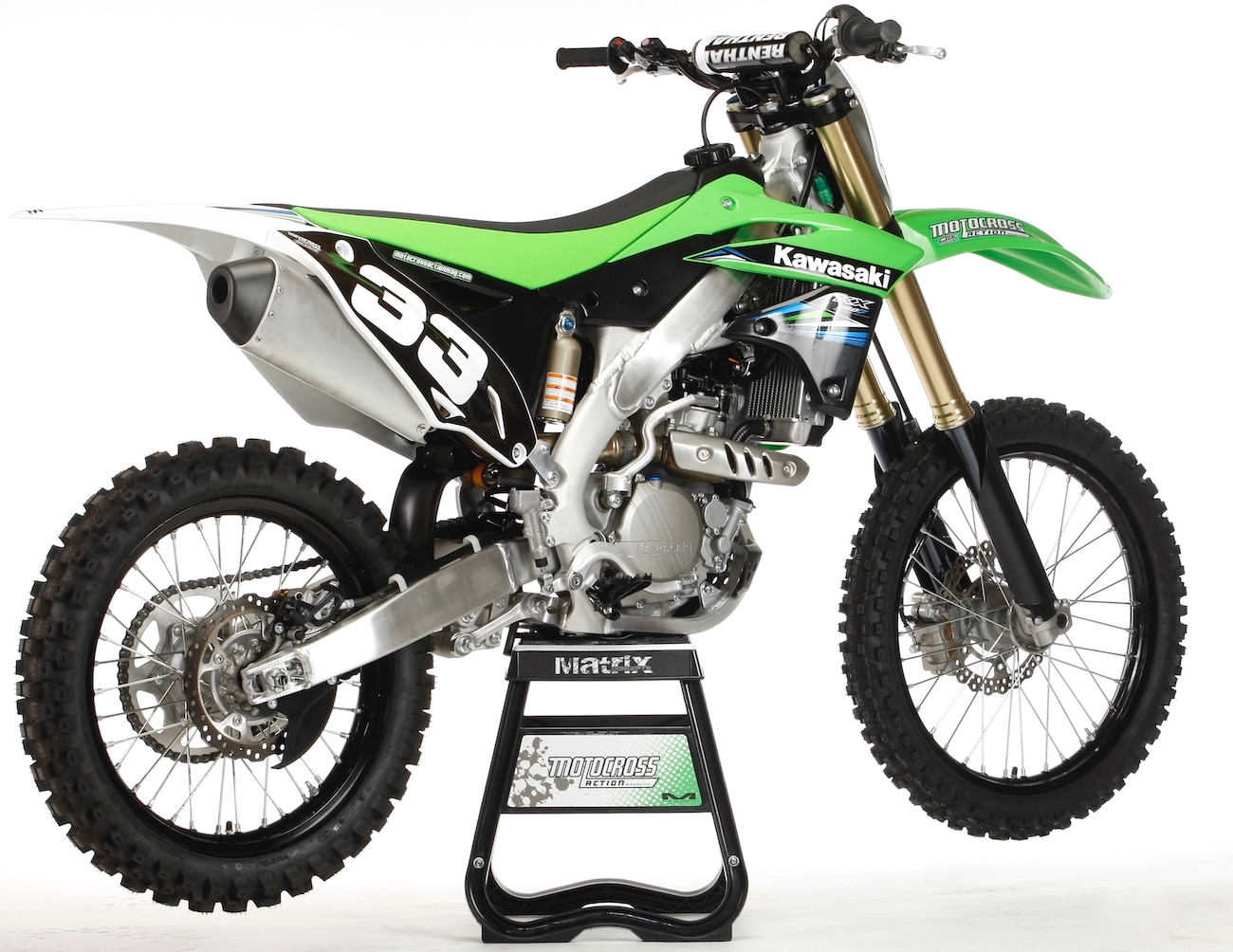
Q: WHAT SIGNIFICANT CHANGES WERE MADE TO THE 2014 KAWASAKI KX250F?
A: Although the 2014 model wasn’t completely overlooked, the number of KX250F updates are a far cry from the boatload of changes made in previous years. In order to answer the question we must turn back the clock and point out the major updates to the 2013 KX250F. Kawasaki massaged 11 areas on last year’s bike with a focus on increased power, electronic fuel injection mapping options, handling performance, balanced suspension and updated styling. The laundry list of changes equated to a superb bike that had few deficiencies. With glowing candor we wrote that Kawasaki “managed to tweak the KX250F to the point of near perfection.”
The MXA wrecking crew didn’t need to blow the dust off our abacus to tabulate the number of changes made to the 2014 Kawasaki KX250F. Here’s the breakdown:
(1) Launch Control. Kawasaki has become very adept at interchanging technology between their line of motocross bikes. Often these groundbreaking advancements are showcased on the KX450F before trickling down to the KX250F. And so it goes with Launch Control. Pushing a button on the handlebars activates Launch Control will retard the ignition timing in first and second gear to prevent wheelspin when starting on concrete or other slippery surfaces. Shifting into third gear deactivates Launch Control, and ignition timing returns to the normal mapping. We never use Launch Control on a 250. It needs all of its power if you want to get the first turn first.
(2) Engine. The KX250F powerplant remained unmolested, save for a tapered crankcase oil jet, which helps send an optimized stream of oil to the underside of the piston. The benefit of this upgrade is twofold–enhanced cooling and added durability. The digital fuel injection (DFI) remains unchanged. The KX250F is the only motocross bike to use two injectors to handle the job of feeding fuel to the engine. Kawasaki changed the positioning of the upstream injector in 2013 for greater power optimization, which aided in midrange and top-end gusto. Kawasaki boasts that the DFI fuel flow capacity is roughly 20 percent greater than on the KX450F.
The KX250F also has optional plug-in couples. The green coupler (standard), black (hard terrain) and white (soft terrain) couplers are easily chnaged and greatly affect the KX250F’s engine characteristics. The black coupler is meant to be used on hard pack tracks, while the white coupler is best suited to loamy or sandy conditions where maximum power is necessary. The green coupler falls somewhere in between.
(3) Transmission. Kawasaki has been revising their transmission for many years. And so it goes for 2014. The KX250F has new transmission gears that feature four dogs instead of three for enhanced shifting smoothness. New shift fork grooves were added for more direct feel at the shifter. Kawasaki also revised the countershaft sprocket interface and retention design, using a nut and washer instead of a clip for more secure mounting, and to make it easier to change the countershaft sprocket. This is the same configuration that the KX450F uses.
(4) Engine mounts. Professional race teams are constantly changing engine mounting plate thicknesses for rigidity and handling traits. Kawasaki is chasing the same benefits. The KX250F uses high-tensile steel engine-mount plates that are 29 percent thinner (3.2mm) than last year’s steel plates (4.5mm) for better rigidity balance and improved front-end grip.
(5) Suspension. Kawasaki revised its Showa SFF (Separate Function Fork) forks. The piston tuning has been adjusted for better performance in the initial and mid-stroke damping. The Uni-Trak Showa shock has new damping settings, and all suspension changes complement the feel of the engine mounts.
(6) Styling. As is the case with all new models, the 2014 KX250F received bold new graphics, which aren’t bold enough to make them easy to differentiate from last year’s scheme. The new bike does have a white rear fender and white side panels that mimic the KX450F.
(7) Controls. Would you believe us if we told you that Kawasaki aborted the longer grip design of two years ago for a 10mm shorter grip configuration? It’s sad but true. We liked the longer grips. The throttle grip isn’t vulcanized to the plastic throttle tube (just like last year), but the clutch-side grip is. You’ll need to buy new handlebars if you want to save yourself the headache of peeling off the stock grip.
Q: WHY HAS THE KAWASAKI KX250F WON MXA’S 250 SHOOTOUT WITH SUCH FREQUENCY?
A: In a word: powerband. The 250 shootout winner is determined by a bike’s ability to blast past the competition, whether into the first turn or out of corners. The KX250F is king in this category. It has no equal. While it’s true that the 2014 KTM 250SXF boasts more horsepower on the dyno, the KX250F has a broader powerband that’s much easier to use. Imagine twisting the throttle at almost any speed and having instantaneous power. That’s what it feels like to ride the KX250F. Yes, the Kwacker has shortcomings. It is not the best suspended or sharpest handling bike in the class, but those faults are mostly forgotten once a rider’s right wrist rotates downward.
Q: HOW DOES THE 2014 KAWASAKI KX250F COMPARE TO LAST YEAR’S MODEL ON THE DYNO?
A: Our 2014 KX250F was identical to last year’s model on the dyno. It makes sense, since Kawasaki didn’t make any performance upgrades to the bike. The KX250F produced a whopping 41.14 horsepower at 12,200 rpm, with 20.36 foot-pounds of torque. Note that this is one of only three bikes to ever break the coveted 40-pony barrier (the others are the KTM 250SXF and Yamaha YZ250F).
Q: HOW WOULD WE DESCRIBE THE POWERBAND OF THE 2014 KX250F?
A: Explosive. Mind bending. The cat’s meow. It will make a slow rider faster and satisfy the needs of a highly-skilled racer. The DFI downstream injector sprays fuel into the 43mm Keihin throttle body at low rpm, and the upstream injector begins to feed fuel at 7000 rpm. At full throttle the upstream injector is doing all of the work, while the downstream injector is shut off. Air velocity reaches the fuel nozzle approximately 120mm above the downstream injector, which better atomizes the gasoline at high rpm. This technology, along with specialized camshaft timing, a shorter cylinder head for increased compression, mapping and exhaust (with resonance chamber) equate to a diabolical weapon of moto destruction.
Less-skilled riders enjoyed the capabilities of the four-valve, double-overhead-cam engine. The powerband wasn’t moody or schizophrenic, but instead free-flowing and vivacious. There were very few weaknesses. Those shortcomings were only felt by Pro-level riders, who voiced that the KX250F engine lacked the top-end gusto that they desired.
Q: IS LAUNCH CONTROL AN ADVANTAGE ON THE 2014 KX250F?
A: No. To us, equipping the KX250F with Launch Control is a feeble attempt at captivating an uneducated audience willing to be swayed by doodads. While we readily admit that Launch Control is a welcome addition to the KX450F, it doesn’t belong on the KX250F. Why? At 55 horsepower, the KX450F can light up the rear tire like a jack-o’-lantern on napalm. It’s true that the KX250F produces eye-watering power, but it lacks the punch to warrant retarding the ignition. At best, Launch Control is suited to beginners. All of our testers tried the button, but they ignored it after a few uses. Why? They felt more confident in controlling wheel spin by using the clutch.
Q: WHAT IS THE SUGGESTED RETAIL PRICE OF THE 2014 KX250F?
A: Inflation is the scapegoat for every business. The rise in oil prices, a worker strike in Asia, a drought in Rwanda—you name it, there’s a reason why everything, from gasoline to ginger ale, is more expensive than last year. Thankfully Kawasaki has bucked this trend with the KX250F for 2014. True, they upped the cost of the KX250F by $600 over the previous four years, but Kawasaki has stood pat on $7599 for the second year in a row. Bravo!
Q: HOW WELL DOES THE 2014 KX250F HANDLE?
A: The KX250F has always handled like a girl getting ready for a blind date–confused, somewhat ditzy, unsure and even a bit nervous. Handling is not one of the shining traits of the KX250F. We have forgiven Kawasaki time and again for producing a bike that cornered with malaise, because we were always enamored by the powerband. And while we can can still forgive the KX250F’s handling traits, Kawasaki needs to address these woes on future models. It’s not that the KX250F is terrible at tracking through ruts or navigating across rough terrain—quite the contrary; however, it pales in comparison to the competition.
The 2014 KX250F has a tendency to understeer in corners. Unfortunately, being too aggressive in corners causes a disastrous push that gave our test riders more than they bargained for. A ride-height adjustment in the Showa SFF forks yielded a more positive feel, but the handling still left a lot to be desired.
Kawasaki improved the Uni-Trak shock in 2013 by targeting its calamitous cohorts. The swingarm was lengthened by 20mm, the shock settings were revised, the upper engine mount stiffened and chassis narrowed by 4mm. As a result, the shock tracked straighter and the wallowing sensation that had plagued the KX250F was lessened. The Showa unit is workmanlike and efficient, but it is hampered by fork settings and a triple clamp offset that left us wanting more.
Q: WHAT CHANGES WOULD WE MAKE TO THE 2014 KAWASAKI KX250F?
A: It’s hard to pick apart a bike that every MXA test rider raved about, but there were chinks in the KX250F’s armor:
(1) Brakes. The push-rod-style, dual-piston front-brake caliper with 250mm disc is light years away from being in the same galaxy as KTM’s excellent Brembo front brake. The KX250F brake offers decent modulation, but it doesn’t have the power to drive deep into corners. Your best bet is to invest in an oversize rotor.
(2) Triple clamps. We’ve had great success swapping out the stock 22.5mm offset triple clamps for 22mm (in some cases we go even steeper). The different geometry sharpens up the handling, making cornering more precise and effective.
(3) Lowering link. Another ode to handling bliss, we opt for a longer lowering-link arm. As a result the rising rate ramps up faster, which reduces wallowing and improves straight-line stability.
(4) Clutch. The biggest downside to a potent powerband is that the clutch will suffer the consequences of handling a heavy load. The KX250F clutch is on the edge of slipping after a few rides and requires stiffer clutch springs (at the very least) to weather the molten storm that brews underneath the clutch cover. Buy a Hinson clutch (www.hinsonracing.com) if you’re determined to solve all the KX250F clutch woes.
Q: WHAT DID WE HATE?
A: The hate list:
(1) Shifting. Surprise! Kawasaki revised the transmission gears for 2014. Surprise! Once again, the KX250F refuses to shift under a heavy load.
(2) Clutch. Buy stiffer aftermarket clutch springs before you walk out the front door of your local dealership.
(3) Chain guide. Sprocket, meet chain guide. Chain guide, meet your worst enemy. It’s time to get T.M. Designworks, at (541) 772-4161, on the horn.
(4) Grips. We were pleased to see that the KX250F came with softer grips that were 10mm longer last year. For 2014 they are 10mm shorter. Hello, McFly? Anybody in there?
(5) Plastics. The fork guards are frail, and we don’t like that Kawasaki the ditched black side panels in favor of white. Why is that important to us? Because 250 class rules require black backgrounds.
(6) Kawasaki’s lawyers. The cotter pin through the rear axle and vulcanized grip on the clutch-side are the the contributions of Kawasaki’s lawyers.
Q: WHAT DID WE LIKE?
A: The like list:
(1) Engine. It rips and it roars. We love the KX250F powerband as much as our wives love chocolate while watching “The Notebook.”
(2) Upstream injector. Two injectors are better than one, particularly with a high-revving 250 four-stroke engine.
(3) Couplers. Kawasaki includes two additional mapping couplers that can be swapped out in a matter of seconds and dramatically change the engine personality. We prefer the white (aggressive) coupler.
(4) Suspension. The Showa units come with better baseline settings than last year, although heavier and faster riders should keep a straight-blade screwdriver nearby.
(5) Sprocket retainer. Gone is the countershaft sprocket circlip. In its place is a nut and indexed washer that are much more secure.
(6) Details. The Kashima coating, blue anodized caps and plugs, black rims (even though they quickly show wear) and curb appeal of the KX250F are attractive qualities. This bike looks great sitting on a stand.
Q: WHAT DO WE REALLY THINK?
A: Not a single MXA test rider voiced any complaints about the fact that Kawasaki didn’t make any significant changes to the 2014 KX250F. That says something. Why? Although not perfect, the KX250F has several major upsides. The breadth and strength of the powerband caters to all skill levels, while the suspension and handling are adequate enough to do the job. The KX250F is defined by its engine. How sweet it is.
MXA’S 2014 KAWASAKI KX250FSETUP SPECS
This is how we set our 2014 Kawasaki KX250F up for racing. We offer it as a guide to help you get your own bike dialed in.
SHOWA SFF FORK SETTINGS
The 48mm Showa SFF has come standard on the KX250F since 2011. It has progressively gotten better, thanks to a stiffer spring rate and damping specs that favored a wider range of riders. The most endearing quality of the SFF package is that ride height can be adjusted. Ride height is very important, as it determines the handling traits. Too much ride height yields a vague feeling at turn-in. To measure ride height, have the rider sit on the bike. Measure from the bottom of the right fork guard to the dust seal. For hardcore racing we recommend this fork setup for the 2014 Kawasaki KX250F (stock specs are in parentheses):
Spring rate: 0.97 kg/mm
Oil height: 300cc in left leg, 223cc in right leg
Compression: 8 clicks out (9 clicks out)
Rebound: 11 clicks ou (12 clicks out)
Preload adjuster: 15 clicks in (7 clicks in)
Fork leg height: 5mm up
Notes: Four clicks on the spring preload adjuster equals 1mm of preload (the old cap needed six clicks for 1mm). There are air bleeder screws at the top of each fork leg.
SHOWA UNI-TRAK SHOCK SETTINGS
Kawasaki is aware that their shock setup needs of improvement. For 2014 they changed the damping. The goal was to accommodate a wider range of riders while sharpening handling and lessening wallowing. The 2014 shock is better than last year’s platform, but the rear end still has a tendency to wallow under a heavy load. We’ve discovered that going in on the high- and low-speed compression, and then adjusting the rebound, seems to do the trick. Ultimately a longer link arm will solve the issue. For hardcore racing we recommend this shock setup for the 2014 Kawasaki KX250F (stock specs are in parentheses):
Spring rate: 5.4 kg/mm
Race sag: 100mm (104mm)
Hi-compression: 1-1/2 turns out (2 turns out)
Lo-compression: 10 clicks out (12 clicks out)
Rebound: 10 clicks out (12 clicks out)
Notes: These settings are geared towards a heavier rider (170-plus pounds). We think that the KX250F works best with the low-speed compression turned in while using the high-speed to adjust the ride height at speed.


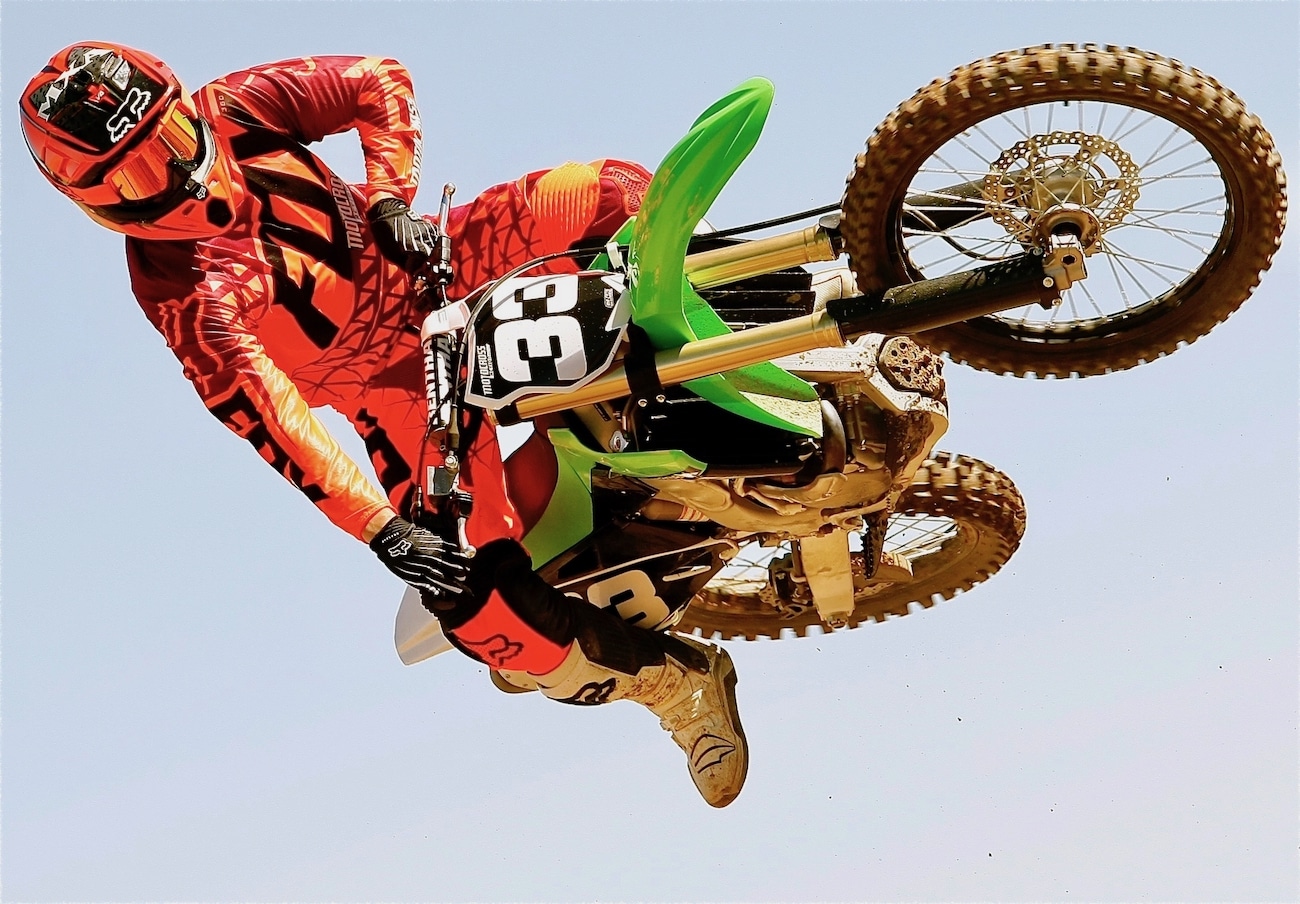
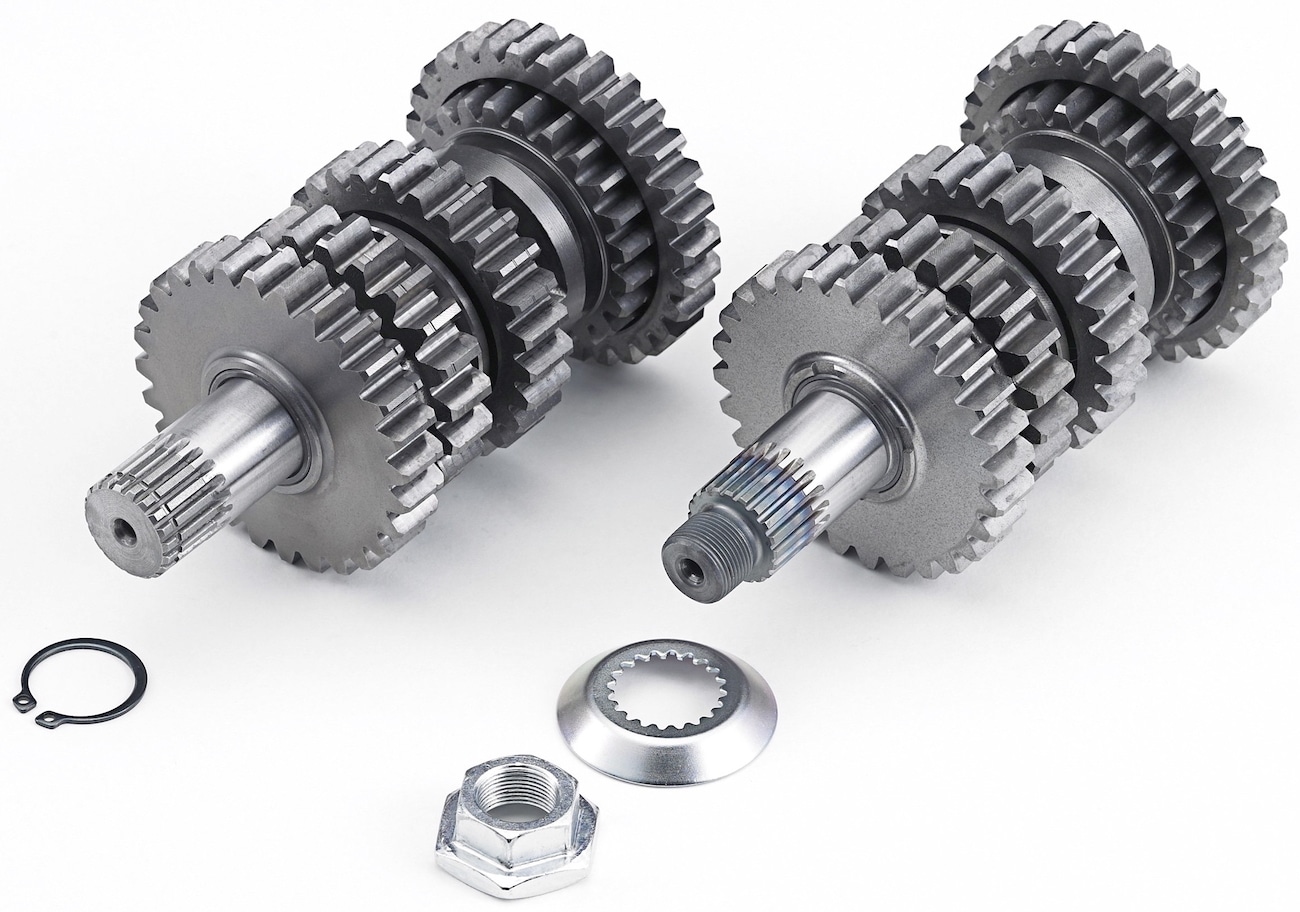
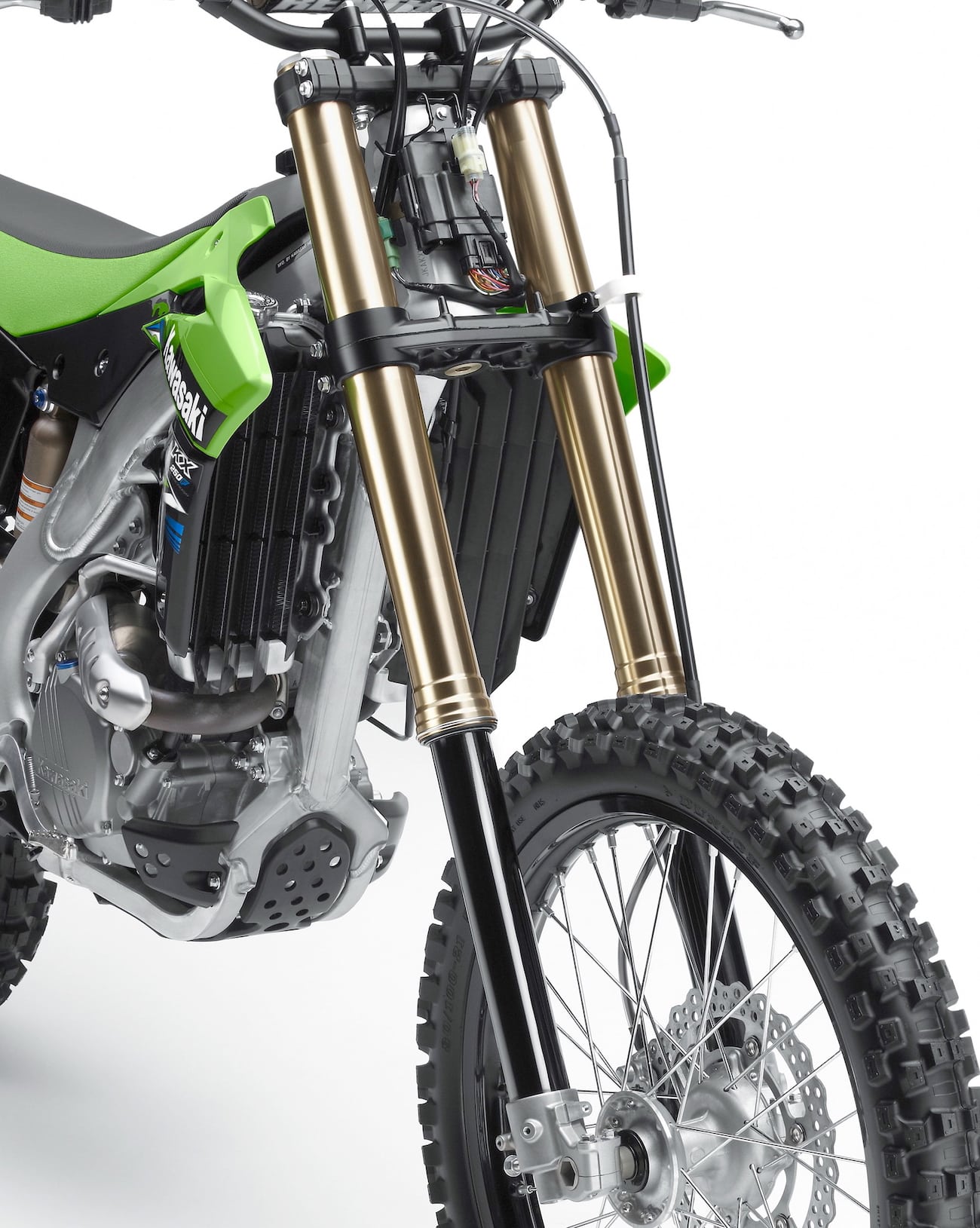
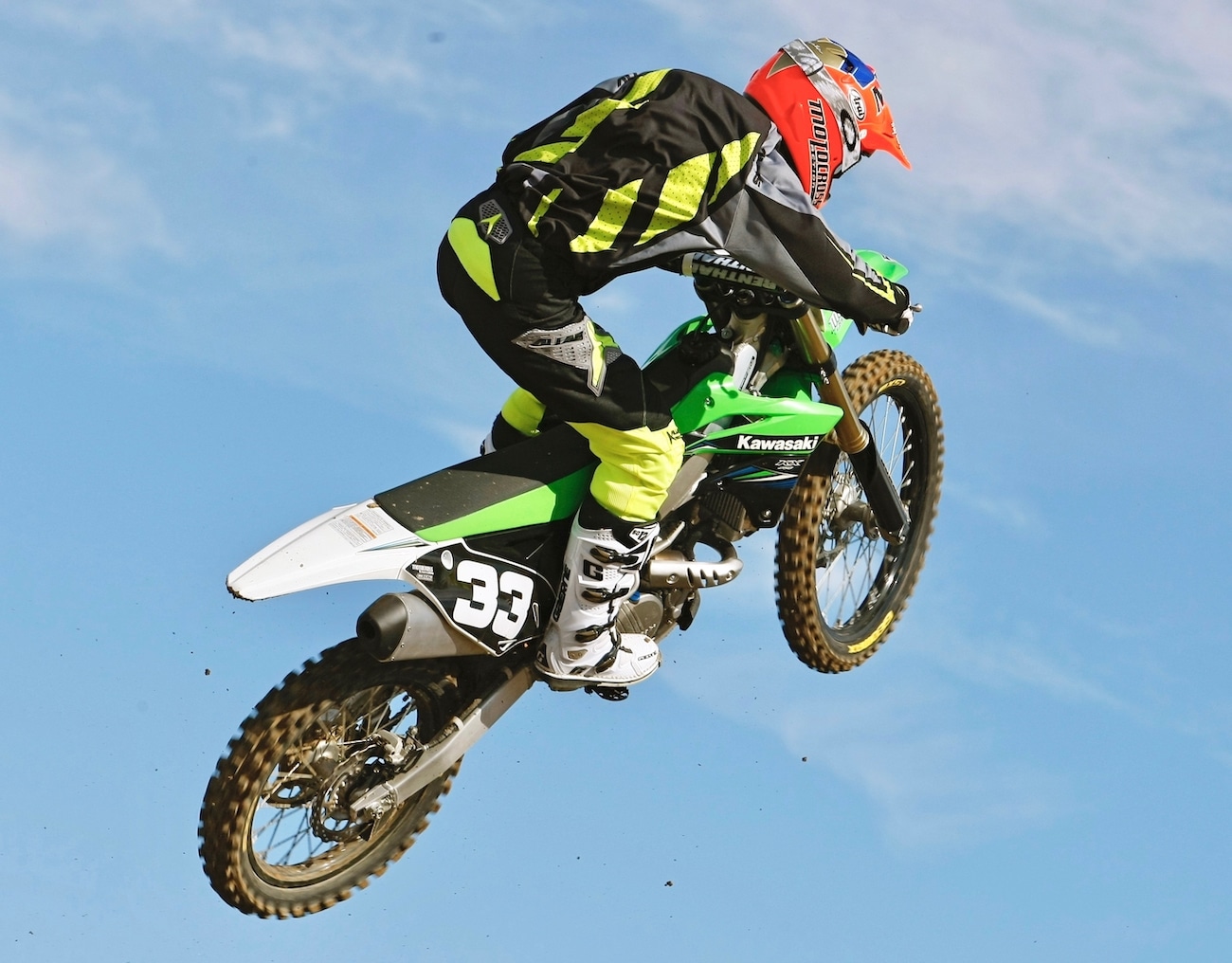
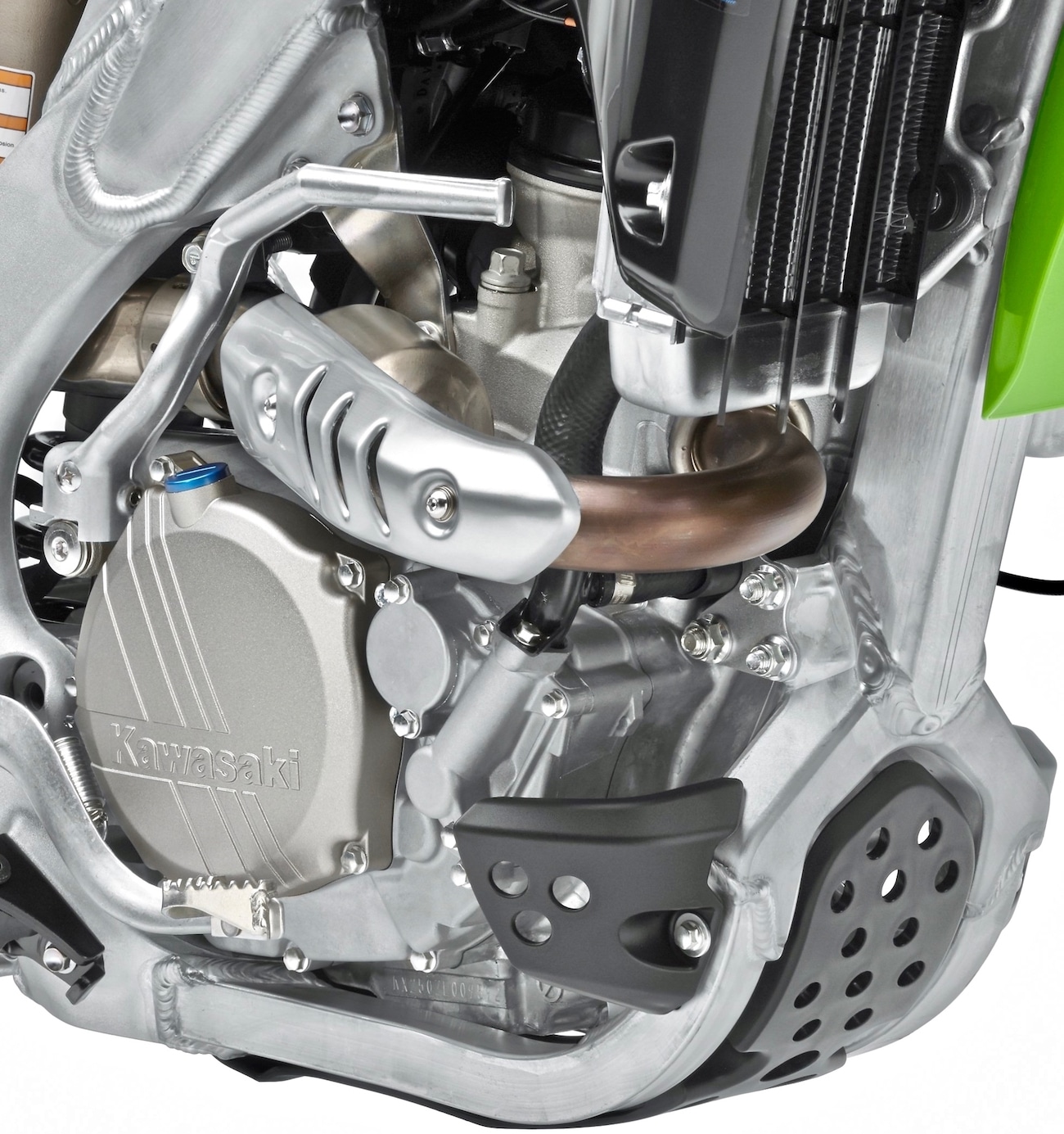
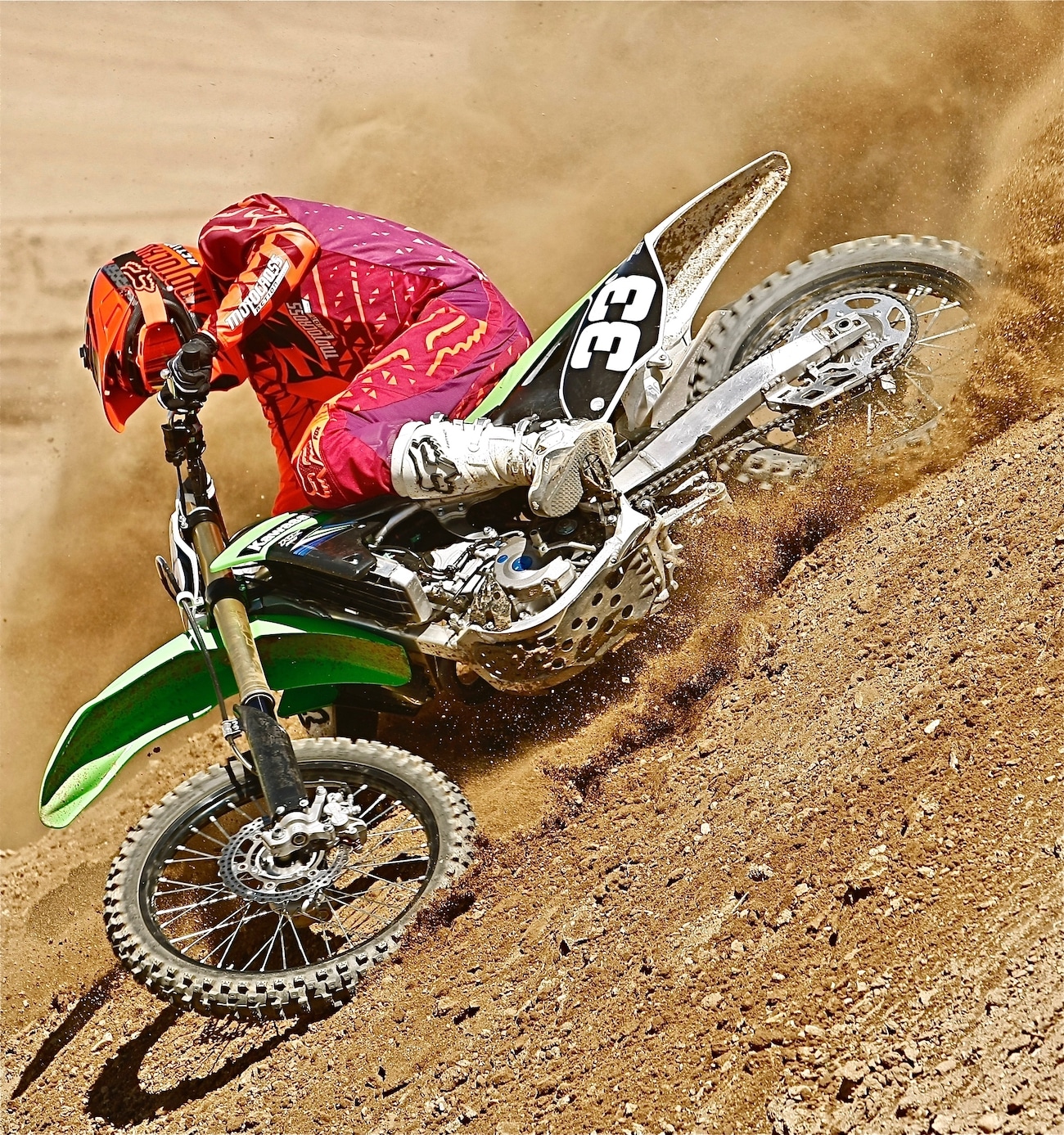
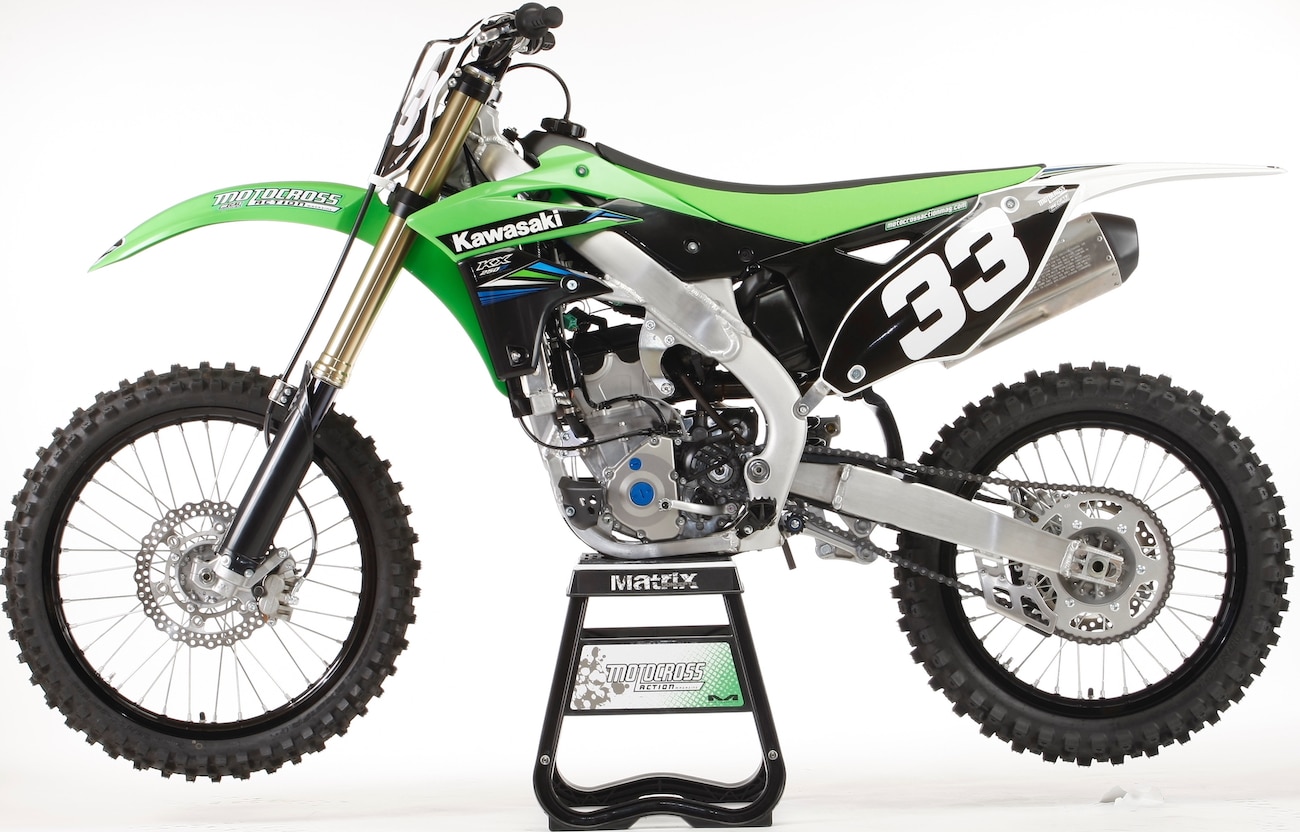
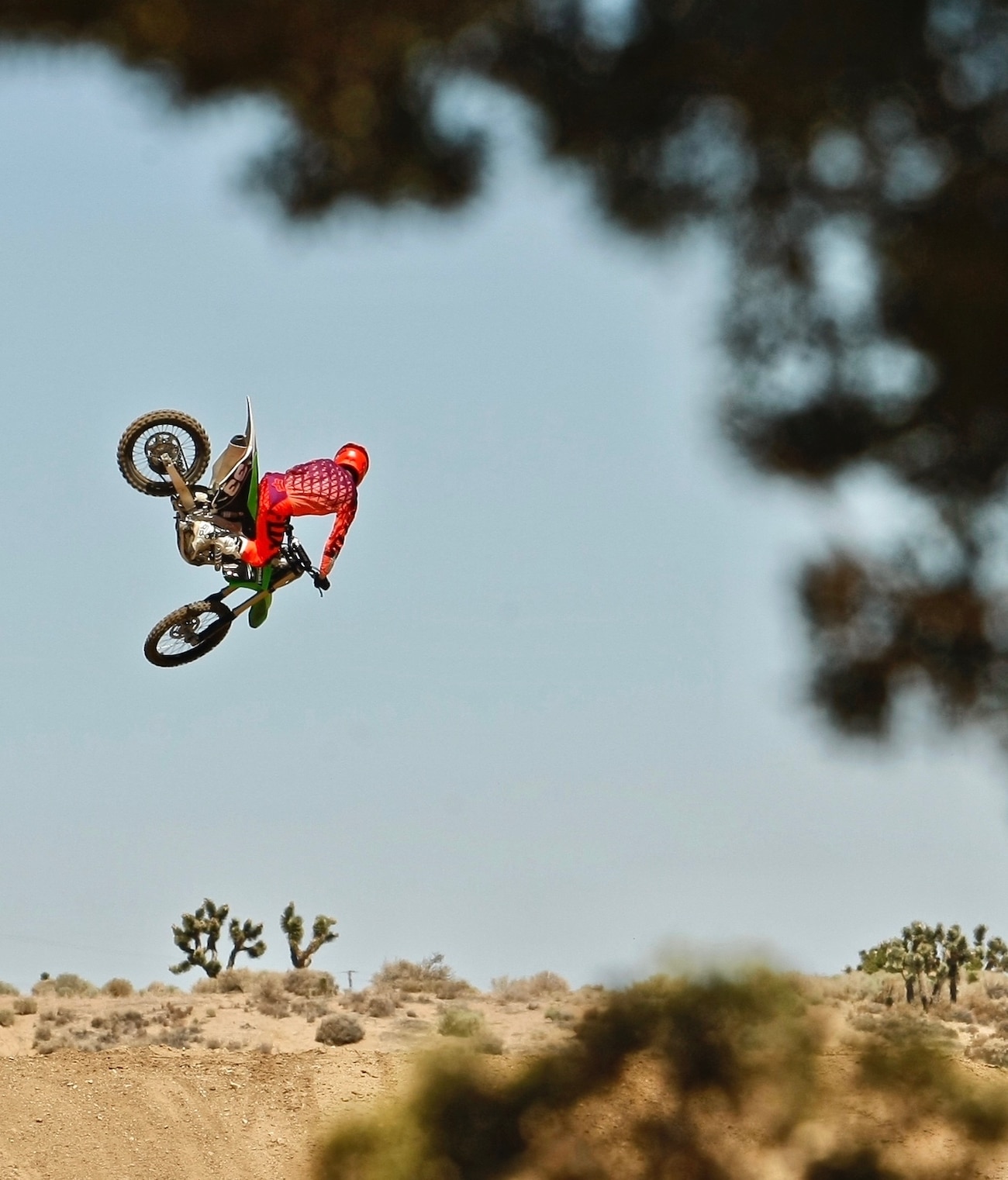
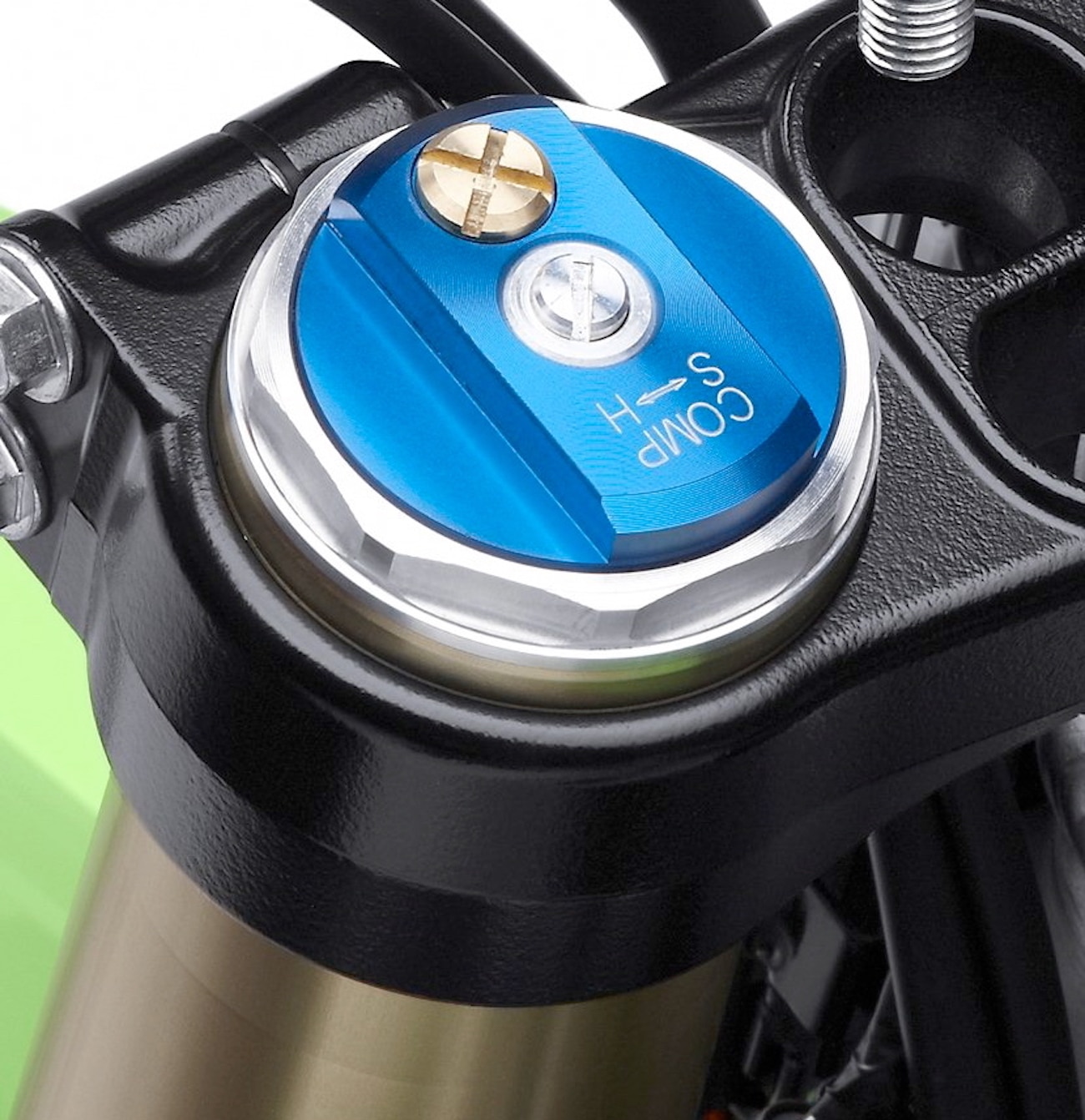




Comments are closed.